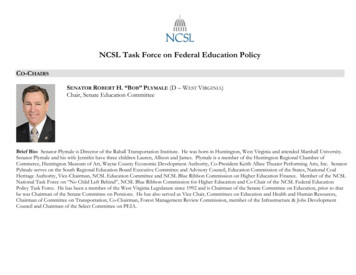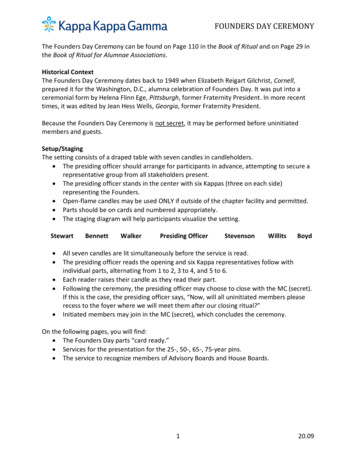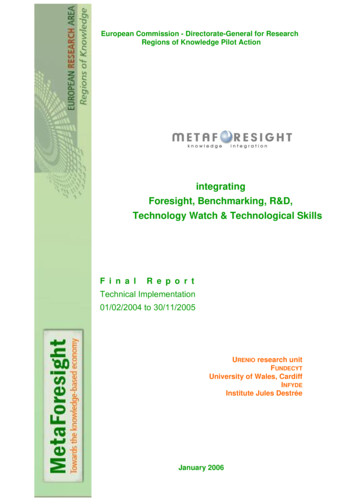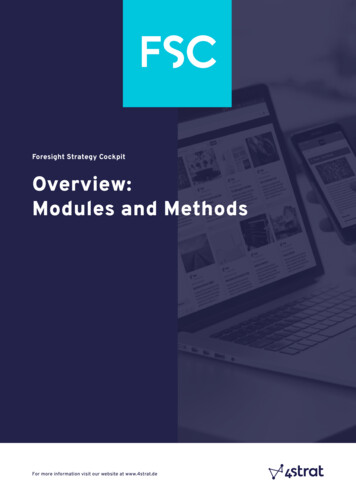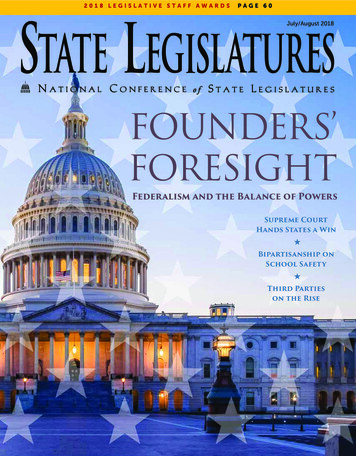
Transcription
2018 LEGISLATIVE STAFF AWARDSPAGE 60July/August 2018FOUNDERS’FORESIGHTFederalism and the Balance of PowersSupreme CourtHands States a Win Bipartisanship onSchool Safety Third Partieson the Rise
PA I D A D V E R T I S E M E N TMAKING A DIFFERENCEFOR A SAFER AMERICAThe firearms industry welcomes participation in the national conversation to make our communities safer.Our trade association, THE NATIONAL SHOOTING SPORTS FOUNDATION, has long advocated foreffective solutions to prevent access to firearms by criminals, children and the dangerously mentally ill.We run programs that make a real difference.NSSF has led the way in improving the FBI National InstantCriminal Background Check System (NICS) through ourFixNICS initiative that has reformed the law in 16 states andimproved the reporting of disqualifying records.The Don’t Lie for the Other GuyTM program helps firearmsretailers prevent illegal straw purchases and is conducted incooperation with Bureau of Alcohol, Tobacco, Firearms andExplosives (ATF).Project ChildSafe has distributed more than 37 million freegun locks since 1999.Our partnerships with federal and state agencies, as well as aleading national suicide prevention organization, are buildingpublic education resources for firearms retailers, shootingSUICIDE PREVENTIONranges and the firearms-owning community.Operation Secure StoreSM is a comprehensive joint initiativewith ATF to help Federal Firearms Licensees make wellinformed security-related decisions to deter and prevent thefts.Practical solutions that protect lives and preserve our citizens’ liberties –making a difference for a safer America.
A National Conferenceof State LegislaturesPublicationJULY/AUGUST 2018VOL. 44 NO. 7 CONTENTSExecutive DirectorWilliam T. PoundEditorJulie LaysAssistant EditorKevin FrazziniThe magazine of state policy and politics from the National Conference of State Legislatures,the bipartisan organization that serves all lawmakers and staff.Contributing EditorJane Carroll AndradeOnline MagazineEd SmithMark WolfContributorsAngela AndrewsSarah HillDylan LynchMegan McClureDan ThatcherBrian WebergJoan WodiskaFEATURESFederalism Forges On Page 14Statehouse Surprise Page 34BY MAX BEHLKE AND JULIE LAYSWhen considering where American federalism is today, it’shelpful to remember where it started.BY KAE WARNOCKWorkers made an interesting discovery while renovatingWyoming’s Capitol.Power in the Bank Page 38Advertising SalesHenry SpringerHenry.Springer@ncsl.orgBY DANIEL SHEAEnergy storage could flip the script on how electricityis managed.CommunicationsInternAnna SmithArt DirectorBruce HoldemanHow to Run a Better Election Page 44BY PATRICK POTYONDYFive things election officials want you to knowNCSL PresidentSenator Deb PetersSouth DakotaTechnology Tests Transparency Page 46NCSL Staff ChairChuck TruesdellFiscal Analyst, LegislativeResearch CommissionKentuckyBY PAM GREENBERGNew apps and sophisticated, high-volume public recordsrequests are straining state sunshine laws.Denver Office7700 East First PlaceDenver, Colorado 80230(303) 364-7700Washington, D.C.,Office444 N. Capitol St. N.W.,Suite 515Washington, D.C. 20001(202) 624-5400State Legislatures (ISSN0147-0641) is published10 times a year by theNational Conference ofState Legislatures. 2018, All rightsreserved. Reproductionin whole or in partwithout permission isprohibited. Requests forpermission to reprintmay be emailed toJulie Lays at: julie.lays@ncsl.org.Opinions expressed inthis magazine do notnecessarily reflect NCSLpolicy. State Legislaturesis indexed in the PAISBulletin and ExpandedAcademic Index. Annualsubscription rates:U.S.— 49; foreign— 55;teachers— 25 (promocode SLMTEA).Single copy: 6.50.Periodically, NCSL rentsmailing labels to otherorganizations. If youprefer your name not beincluded please send awritten request.Postmaster: Sendaddress changes to:State Legislaturesmagazine, 7700 EastFirst Place, Denver, CO80230.When the Rules Aren’t Enough Page 56Supreme Court Hands Federalism a Victory Page 17BY WILLIAM T. POUNDThe South Dakota v. Wayfair ruling expands states’ abilityto collect sales taxes.A Team of Their Own Page 18BY JOHN MAHONEYIndependents and third-party legislators are succeedingby staying outside of party lines.Finding Common Ground Page 22BY BEN ERWINLegislators are working across the aisle to find ways to ensurethat students and staff are safe while at school.BY BRENDA ERICKSONTo be effective, you need to know—and play by—establishedparliamentary procedures.Pathway to Public Service Page 26BY HOLLY SOUTHLegislative internships have launched many on their politicaljourneys.Tools for Your Tote Bag Page 30Find more information and linksto resources on topics covered inthese pages at SL Online. Go to ncsl.org/magazineEvery legislator can be effective. It just takes the rightequipment. NCSL can help.STATE LEGISLATURESSL OnlineState Legislatures magazine is printed on recycled paper.3JULY/AUGUST 2018
JULY/AUGUST 2018VOL. 44 NO. 7 CONTENTSDEPARTMENTSSHORT TAKES PAGE 5STATESTATS PAGE 55Connections, support, expertise and ideas from NCSLHow does your state score? New“scorecard” data show state performanceover time in restraining costs and improvingaccess to health careINNOVATIONS PAGE 7Strengthening the legislative institution: Oregon’s first-in-the-nationCapitol Diversity, Equity and Inclusion CommitteeNEWSMAKERS PAGE 58TRENDS PAGE 8What’s happening under the domesEnergy-efficient buildings, community health centers, internetderegulation, defense spending and the states, minimum marriage agesand tariff tensionsLEGISLATIVE STAFF AWARDS PAGE 60YES, NO, MAYBE SO PAGE 61STATELINE PAGE 32This month’s ethics question: Do legislatorshave a right to privacy?News bites from across thecountry—from halting pet leasing inCalifornia and Nevada to hardeningthe statehouse in North CarolinaTHE FINAL WORD PAGE 62Meet California Assembly SpeakerANTHONY RENDON“I encourage legislators around the countryto look at all that we’re doing here inCalifornia versus what’s not happening inWashington, D.C.”WHAT STAFF KNOW PAGE 42Legislative auditors and evaluatorsseek to find the truth throughskepticism and independence.Our American States is where you hear compellingconversations that tell the story of America’sstate legislatures, the people in them, the politicsthat drive them, and the important work ofdemocracy. Listen online or subscribe today.Check out these and other past episodes:n Security of American Electionsn State Health Spendingn Tackling Sexual Harassment in the Legislaturen The State of State Legislatures 2018www.ncsl.org/podcastAvailable onJULY/AUGUST 20184STATE LEGISLATURES
NCSLEXPERTISE“While Tennesseehas similarlegislation pending,no other state haspassed a law likethe one in SouthCarolina.”Sunny Deye on South Carolina’sbill to fight anti-Semitism oncollege campuses, from Reuters.“More and morestates are passingcomprehensivemarijuanaprograms.”Karmen Hansonon state lawmakers respondingto increasing public support forlegalized medical marijuana, onpbs.org.“It’s a complicatedissue, and no twostates are thesame.”Ethan Wilson onstate efforts toimpose taxes and fees on sportsbetting and internet gambling, inthe Philadelphia Tribune.“Many legislatureshave realized thatwhile their policiesare strong, theoverall environmentneeds to change.”Jon Griffin on sexual harassmentpolicies and the workplace culturein statehouses, in Governingmagazine.SUPPORTNCSL Goes Back to SchoolMembers of NCSL’s Student-Centered LearningCommission went back to the classroom in NewHampshire. The bipartisan group of 16 lawmakersfrom eight states visited schools participating ina first-in-the-nation, competency-based pilotprogram that uses fewer standardized tests andmore locally developed performance assessments.Competency education, in which students mustdemonstrate mastery of a subject before receivingcredit, is expanding across the country. Legislatorswant to understand what it is, how to implementit and how to support it. The commission, whichwas formed last year, will release its findings in2019. For information, contact Sunny Deye inNCSL’s Education Program.Students at Parker-Varney Elementary School inManchester, N.H., produce videos, design projectsand direct much of their own learning.CONNECTIONSFoundation Welcomes New SponsorsThe NCSL Foundation for State Legislatures works to strengthen state legislatures, counteract cynicism aboutgovernment, and help solve pressing state issues with public-private partnerships and dialogue. It supports NCSL’sCenter for Ethics in Government, the Women’s Legislative Network and a host of special projects, including leaders’services, e-learning, civic education, international programs and more. The foundation gratefully welcomes thefollowing new and upgraded sponsors:AbbvieAmerican ExpressAmerican WaterAuto Care AssociationBiogenBOMACelgeneCouncil for Affordable Quality HealthcareConsumer Data Industry AssociationConsumer Technology AssociationEcoLabExpress ScriptsFresenius Medical CareGlaxoSmithKlineNational Community Pharmacists AssociationNurse Family PartnershipsPepsiCoPhysicians for Fair CoverageRELX GroupSazarecTSYSWant to know more? Contact Caroline Carlson, director of development, for information.IDEASNeed to Dig a Little Deeper?Check out our new research reports. Unbiased. Comprehensive. Easy to Read. Always.STATE LEGISLATURES5JULY/AUGUST 2018
THANKS TO OUR SPONSORS FOR THEIR GENEROUS SUPPORTPLATINUM1-800 CONTACTS, Inc.Advance AmericaAmerican WaterAmgenAnthemAppleAT&TCharter CommunicationsComcast Cable CommunicationsConsumer Technology AssociationEntertainment Software AssociationGenentechGilead SciencesGlaxoSmithKlineHP Inc.Institute of Scrap RecyclingIndustries, Inc.International PaperInuitGOLD21st Century FoxAARPAbbVieADMThe Advocacy Group (TAG)/Focus,a Leonine BusinessAlkermesAlliance of Automobile ManufacturersAmerica’s Credit UnionsAmerica’s Health Insurance PlansAmerican AirlinesAmerican Association for JusticeAmerican Bankers AssociationAmerican College of CardiologyAmerican Council of Life InsurersAmerican Dental AssociationAmerican ExpressAmerican Federation of State, County &Municipal EmployeesAmerican Federation of TeachersAmerican Fuel & PetrochemicalManufacturersAmerican Gas AssociationAmerican Heart AssociationAmerican Hotel & Lodging AssociationAmerican Institute of CPAsAmerican Institutes of ResearchAmerican Optometric AssociationAmerican Public Power AssociationAmerican Society of Civil EngineersAnheuser-Busch CompaniesAssociation for Accessible MedicinesAstraZenecaBank of AmericaBayer HealthCare PharmaceuticalsBest BuyBiogenBlueCross BlueShield AssociationBoehringer IngelheimCapital OneThe Carpet & Rug InstituteCelgeneCenturyLinkCharles Koch InstituteChevronThe College BoardConsumer Data Industry AssociationCox Communications, Inc.Crown Cork & Seal Company, Inc.CTIA— The Wireless AssociationDaiichi Sankyo, Inc.Darden Restaurants, Inc.Design-Build Institute of AmericaDJIEdChoiceEdison Electric InstituteEverytown for Gun SafetyExpedia, Inc.SILVERAAAACS Cancer Action NetworkAdvantage CapitalAflacAgriumAir-Conditioning, Heating, andRefrigeration InstituteAlliant EnergyAlzheimer’s AssociationAmerican Association of NursePractitionersAmerican Chemistry CouncilAmerican Coatings AssociationAmerican Electric PowerAmerican Financial Services AssociationAmerican Forest & Paper AssociationAmerican Hospital AssociationAmerican Insitute of ArchitectsAmerican Medical AssociationAmerisourceBergenArgentumAsh Grove Cement CompanyAssociation of American RailroadsAuto Care AssociationBDBOMA InternationalBoston ScientificBrewers AssociationBristol-Myers SquibbCEDIAThe Coca-Cola CompanyCompTIAConsumer Healthcare ProductsAssociationCouncil for Affordable QualityHealthcareCropLife AmericaCumminsCVSDiageoDominion Energy, Inc.eBay, Inc.EcolabEducational Testing ServiceEquipment Leasing and FinanceAssociationLas Vegas Sands Corp.MAXIMUSMylanNCTA—The Internet & CableAssociationNovartisNuclear Energy InstitutePepsiCoThe Pew Charitable TrustsPhRMARELX Inc.Reynolds American Inc.SignifyState Farm Insurance CompaniesTIAAUniversity of PhoenixVisaWalmartWeedmapsFacebookFoundation for Individual Rights inEducationGoogleHIMSSIBMInternational Council of Shopping CentersLexisNexis State NetLockridge Grindal Nauen P.L.L.P.Mallinckrodt PharmaceuticalsMasterCard WorldwideMcKesson Specialty HealthMerckMicrosoftMultiState AssociatesNational Association of ConvenienceStoresNational Athletic Trainers’ AssociationNational Beer Wholesalers AssociationNational Education AssociationNational Retail FederationNational Rural Electric CooperativeAssociationNovo NordiskNurse-Family PartnershipNWEAofoOrganization for International InvestmentPayPalPearsonProfessional Beauty AssociationReason FoundationRed BullRoche DiagnosticsSalt River ProjectSanofiSAS InstituteSazeracSiemensSociety for Human Resource ManagementSodexoSprintState & Federal Communications, Inc.StatesideTargetTeva Pharmaceuticals USAT-MobileTSYSUltragenyxUPSVistra EnergyWalgreensWaste ManagementWells FargoWest, A Thomson Reuters BusinessWireless Infrastructure AssociationExpress ScriptsExxonMobilFidelity InvestmentsFresenius Medical CareGeneral MillsHallmark CardsHelicopter Association InternationalThe Hershey CompanyThe Human Society of the United StatesInternational Bottled Water AssociationJohn DeereJohnson ControlsJohnson & JohnsonJPMorgan Chase & Co.MAGNA InternationalMattel, Inc.McLane Company, Inc.Molina HealthcareMotorola SolutionsNational Association of Chain DrugStoresNational Association of Home BuildersNational Community PharmacistsAssociationNational Electrical ManufacturersAssociationNational Federation ofIndependent BusinessNikeNorthrop GrummanOutdoor Industry AssociationPersonal Care Products CouncilPhilips HealthcarePhysicians for Fair CoverageProperty Casualty Insurers Associationof AmericaRetail Industry Leaders AssociationSatellite Broadcasting andCommunications AssociationSecurities Industry andFinancial Markets AssociationService Employees International UnionSolar Energy Industries AssociationTax FoundationToyota
I nclusivityGenderDi ver sit yPower, EthnicityE q u it yGot a Capitol DEI Committee? Oregon Does.In 2016, well before the revelations thatenergized the #MeToo movement,staff and members in Oregon begandiscussing ways to make the Capitola more diverse, equitable and inclusiveplace. The conversation grew out of arecognition, House Speaker Tina Koteksays, that more constituency groups thanever—particularly communities of color—were coming to the building to representand advocate for the broader population.Two years later, the discussion hasled to action: the creation of the CapitolDiversity, Equity and Inclusion Committee and a new full-time staff position withthe title accessibility and inclusion administrator. The committee already is planning and developing an agenda that willguide it through 2019. And the new staffposition, which will be part of the humanresources office, was recently posted.In keeping with the goal of improvingthe Capitol’s workplace culture holistically, the committee includes legislatorsand staff, Kotek says. The group recentlydeveloped definitions of what it means bythe terms diversity, equity and inclusion.On diversity, its definition includesfamiliar references to race, ethnicity andgender but also addresses “power relationships in which the dominant culturalgroup is viewed as one up and the subordinate cultural group is viewed as onedown.” Equity, the committee writes,“involves striving to identify and eliminatebarriers that have prevented the full participation of some groups.”An inclusive climate, the committeesays, “embraces differences and offersrespect in words and actions for allpeople.” But it cautions that “a diversegroup isn’t always inclusive.” It says that,STATE LEGISLATURES7JULY/AUGUST 2018“Increasingly, recognition of unconsciousor ‘implicit bias’ helps organizations tobe deliberate about addressing issues ofinclusivity.”The new administrator position maybe unique among the state legislatures.Oregon’s legislature has long been a leaderin human resource management, and thisinitiative fits with its pattern of innovationin human resource practice.According to the job posting, the newadministrator will develop the “inclusionand equity program’s long-range plans,goals, objectives and milestones,” and“engaging the organization in a dialoguethat promotes understanding, respect andinclusion in the work environment.”Perhaps most important, “This newposition is part of a comprehensive effortto make the Oregon Capitol a modelworkplace,” Kotek says.
TRENDSTo Efficiency and BeyondLLawmakers address building energy use through state commercial and residential building energy codes, which have beenadopted in most states and the District of Columbia. By updatingor strengthening their codes, states can help building owners andrenters realize the economic and comfort benefits of increased efficiency.Beyond-code policies include those that mandate adherence toLEED or other standards and those that set net-zero energy building requirements—the concept that a building produces as muchenergy as it uses, or more, by combining a high degree of efficiencywith on-site renewable energy generation.California’s Long-Term Energy Efficiency Strategic Plan, forexample, set a goal for all new residential and commercial construction to meet net-zero standards by 2020 and 2030, respectively. Ahandful of cities also have established net-zero targets, includingSanta Monica, Calif., which approved an ordinance in 2017 requiring all new single-family construction to be rated net-zero.To encourage going beyond code, states have created incentivesor financing initiatives for high-efficiency buildings. Arizona, forexample, enacted legislation in 2016 that amended tax incentivesfor data centers to include certain newly constructed facilitiesthat meet Energy Star, Green Globes, LEED or comparablestandards. In 2014, Maryland legislation established anenergy-efficient home construction loan program andfund to build low-energy and net-zero homes.Some states have set “lead by example” policies, creating efficiency and green-buildingrequirements for government-owned facilitiesor state-funded projects. In Hawaii, 2015 legislation set a collective goal for the Universityof Hawaii system to be rated net-zero by 2035,and 2017 legislation created a revolving loanfund to help meet that goal. Rhode Island lawmakers enacted companion bills in 2017. Oneexpanded the state’s Green Building Act toinclude public real property; the other updatedstandards, including LEED for building projects, LEED for Neighborhood Developmentand the Green Building Council’s SustainableELECTRIC CARSites.READY GARAGEIn the last two years, at least a dozen statelegislatures enacted bills on high-efficiencybuildings, and in this session at least eightstates have introduced legislation related togreen and net-zero buildings. As they strive forgreater efficiency and more vibrant economies,states may continue going beyond code toachieve their energy conservation goals.— Megan Clevelandawmakers have caught a bit of Buzz Lightyear’s enthusiasmwhen it comes to buildings and energy efficiency.But instead of going beyond infinity, like Buzz, theywant builders to go “beyond code”—that is, beyond traditional energy code requirements for buildings. The policies they’reconsidering incorporate established green-building rating systems:the U.S. Green Building Council’s Leadership in Energy and Environmental Design, known as LEED; the Green Building Initiative’sGreen Globes; the U.S. Environmental Protection Agency’s EnergyStar; or net-zero energy requirements.It takes a lot of energy to power buildings. Residential, government and commercial structures accounted for 39 percent of U.S.energy consumption in 2017, according to the U.S. Energy Information Administration.This power doesn’t come cheap. The electricity required to lightcommercial buildings amounts to more than 35 billion a year, theU.S. Department of Energy estimates. That’s before adding thecosts of maintaining comfortable temperatures, heating water orpowering appliances, computers and office equipment. Loweringbuilding energy use not only decreases operating costs, but alsoreduces air emissions and strain on the electric grid.JULY/AUGUST 20188STATE LEGISLATURES
TRENDSHealth Centers Filling the GapsThe federal Bipartisan Budget Actshowed continued support forcommunity health centers, whichserved around 27 million patientsin 2016, more than ever before. The lawincreases health centers’ discretionarygrant funding, bringing the total fundingfor the centers to 5.4 billion. The moneyhelps to expand the availability of primarycare at health centers across the country.That’s good news for the millions ofpatients who use these nonprofit, community-directed facilities for most of theirmedical needs. Also known as federallyThe PatientsHealth centers served close to 27 millionpatients in 2016. 1 in 6 Medicaid patients1 in 5 uninsured individuals1 in 3 people living below poverty line1 in 6 rural residentsSource: National Association of CommunityHealth Centers, 2017qualified health centers or, simply, health centers, they operateThe Cost Factorin more than 10,400 underThe insurance status of health center patients in 2016served rural and urban communities across the U.S., serving all49% Medicaid or CHIP recipientswho come through the doors,23% Uninsuredregardless of their insurance17% Privately insuredor financial status. The centers9% Medicare recipientsoffer a full range of primary2% Otherand preventive medical services,Source: National Association of Community Health Centersalong with translation, healtheducation and transportationassistance, when needed.cover their costs. In addition, some healthAs their use grows, more are addingcenters also receive state grants to mainsupplemental services, such as dentistry,tain various services. In FY 2017, 33 statesbehavioral health care, pharmacies andprovided direct funding to health centers,substance abuse treatment. Studies indiseveral tapping into tobacco taxes andtobacco settlement funds.cate these centers increase access to careHealth centers employ nearly 213,000and improve patients’ health. For exampeoplenationwide who not only offerple, health center patients have fewerpatients cost-effective care, but alsolow-birthweight babies and higher controlgenerate economic activity in their localrates of diabetes and blood pressure thancommunities, estimated at 45.6 billionthe national averages.in 2014, according to Capital Link, aBut they couldn’t survive withoutnational nonprofit dedicated to strengthadditional funding. Since only 17 percentof health center patients carry privateening community-based health care.insurance, centers rely on federal grants to—Samantha ScottiInternet DeregulationThe Restoring Internet FreedomOrder, which the FederalCommunications Commissionissued early this year, becameeffective June 11. It repeals net neutralityrules established in 2015 that preventedinternet service providers from blocking,slowing down or speeding up the deliveryof content, or favoring one website orapp over another. Supporters say thenew FCC order was needed to replacethose “unnecessary” and “heavy-handed”regulations with strong consumerprotections, increased transparency andcommon-sense regulations that will pavethe way for better, faster, cheaper internetaccess.Many doubt those claims, fearing thatrepealing net neutrality rules will givemajor telecommunications companiesunprecedented control over how we usethe internet. As of June 1, legislators in 30states had introduced more than 65 bills orresolutions in support of maintaining netneutrality principles. Oregon, Vermont andWashington passed legislation. Governorsin Hawaii, Montana, New Jersey, NewYork, Rhode Island and Vermont havesigned executive orders requiring companies wishing to contract with the stateto confirm they will follow net neutralityrequirements. In addition, the mayors of atleast 120 cities also have pledged to requireentities contracting with them to adhere toSTATE LEGISLATURES9JULY/AUGUST 2018net neutrality rules.The rule change also gives primaryjurisdiction over internet service providers’practices to the Federal Trade Commissionand pre-empts actions states take to reinstate net neutrality restrictions. Attorneysgeneral from 22 states have filed a protective petition for review against the FCC inthe U.S. Court of Appeals seeking a determination that the order violates federal lawand is “arbitrary” and “capricious.”—Danielle Dean
TRENDSDefense Spending and the StatesThe U.S. government spends defense dollars in every statethrough purchases of military equipment, wages forservice members and civilians, pension payments, healthcare services and grants to states.But the size and mix of those investments vary substantially bystate, so changes in defense spending will affect each state differently. The effects also depend on which programs and operationsare increased or cut.This analysis of defense spending in the states goes beyond con-tracts and salaries to include retirement payments, nonretirementbenefits and grants.In fiscal year 2015—the most recent year for which completedata are available—federal defense spending totaled 485 billionin the states and the District of Columbia, or 1,510 per person.The amount spent by state per capita ranged from 386 in Michigan to 7,132 in Virginia. The District of Columbia received thehighest amount of spending per capita at 10,413.—Anne StaufferDistribution of Federal Defense SpendingThe Big FivePer capita by state, federal fiscal year 2015; average was 1,510.Defense spending falls into these categories. Contracts for purchases of goods andservices, such as military equipment, informationtechnology, and operations and maintenanceprograms, accounted for 56 percent of allspending in the states. This was the largestcategory in 35 states and the District of Columbia,and it made up at least 70 percent of federaldefense dollars in Connecticut, Massachusetts,Minnesota, Missouri and Pennsylvania. Salaries and wages for active-duty military,civilian, reserve and National Guard personnelaccounted for 28 percent of total spending.California, Texas and Virginia received nearly onethird of these funds, reflecting the high numbersof federal defense employees in these states. For13 states, this category was the largest. Retirement benefits, which are payments toindividuals for military pensions, accounted for 12percent of spending in the states. More than onethird of the total went to California, Florida, Texasand Virginia. Nonretirement benefits, which are paymentsfor health care provided through the military’sTricare Management Program, accounted for 3percent of spending. More than one-fifth of thesefunds went to Florida and Texas. Grants, which include funding to stateand local governments for programs such asNational Guard activities, medical research anddevelopment, and basic and applied scientificresearch, accounted for 1 percent of spending.More than one-fifth of these funds went toCalifornia and Maryland.— Anne Stauffer, Justin Theal and Laura Pontari,The Pew Charitable TrustsRIDCPRVIGUMPASMore than 1,700 900 – 1,700Less than 900No dataNotes: Defense spending is defined as expenditures by the Department of Defense on salaries andwages for military personnel as well as retirement and nonretirement benefits (e.g., military pensionsand health care services, respectively) and obligations for contracts for purchases of goods andservices, such as weapons systems and information technology consulting, and grants to state andlocal governments. Contracts spending also includes “purchases by non-DOD agencies which end upin DOD products,” as reported by the Office of Economic Adjustment.Sources: Pew’s calculations using data from the U.S. Department of Commerce’s Bureau of EconomicAnalysis, Annual State Personal Income and Employment, “Personal Current Transfer Receipts (SA35),”accessed February 2018; USASpending.gov, accessed Feb. 7, 2018; U.S. Department of DefenseOffice of the Actuary, “Statistical Report on the Military Retirement System, Fiscal Year 2015” (2016);Department of Defense Office of Economic Adjustment, “Defense Spending by State, FY 2015”(2017);and U.S. Census Bureau, “Annual Estimates of the Resident Population for the United States”(December 2017).Anne Stauffer is a project director, Justin Theal is a senior associate and Laura Pontari is an associate with The Pew Charitable Trusts’ fiscal federalism initiative.Pew published this article on April 9, 2018.JULY/AUGUST 201810STATE LEGISLATURES
TRENDSOne Size Legislature Fits All?When lawmakers considerchanging the sizes of theirchambers, the debatetypically centers on threemajor themes: representation, efficiencyand cost. This year, at least three statelegislatures debated downsizing.Pennsylvania, with the second largestnumber of lawmakers in the country, isconsidering a bill to shrink the GeneralAssembly from 253 members to 189 members—50 senators to 38, 203 representativesto 151. Representative Jerry Knowles (R),who introduced the bill, toldpublic radio that, with fewermembers, there “would justbe better discussion, betterdebate.” In a smaller legislature, the responsibility ofeach member increases andRepresentativelegislators become moreJerry KnowlesPennsylvaniavisible, supporters argue.It’s also cheaper to shrink.Pennsylvania would save an estimated 15million a year if Knowles’ bill passes andcitizens approve it.But rural lawmakers worry that if thenumber of legislators is decreased and theAlaska Senate chambersize of districts is increased, it will be moredifficult to connect with constituents. Themore the members, the fewer the constituents for each. With fewer constituents,opponents to these bills argue, it’s easier tohave face-to-face dea
Argentum Ash Grove Cement Company Association of American Railroads Auto Care Association BD BOMA International Boston Scienti c Brewers Association Bristol-Myers Squibb CEDIA e Coca-Cola Company CompTIA Consumer Healthcare Products Association Council for A ordable Quality Healthcare CropLife America Cummins CVS Diageo Dominion Energy .

